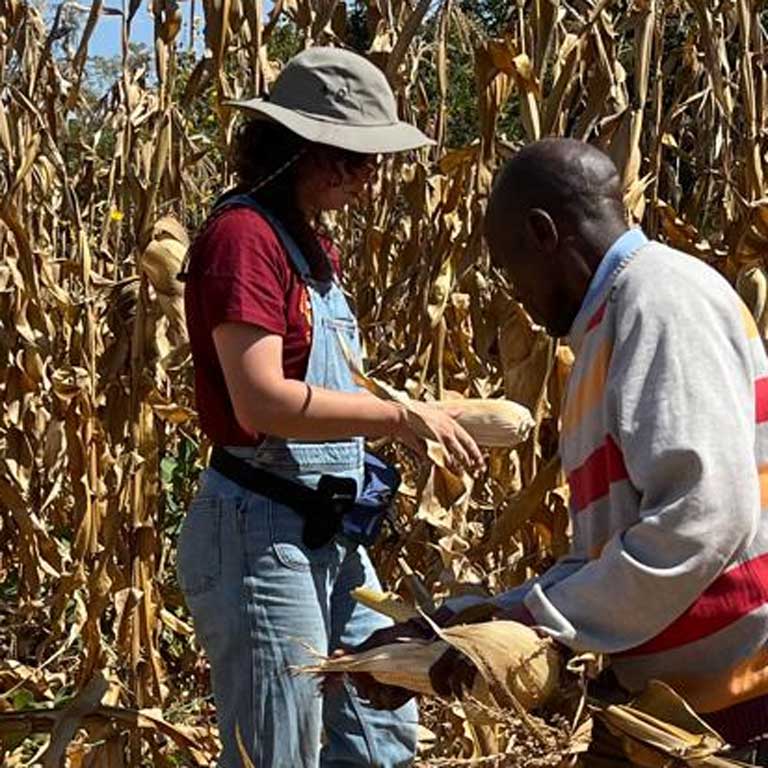By Sydney Foreman (’23)
Sydney Foreman is a Geography major with a focus on Food and Agriculture Systems, who graduates this December.
Spotlight: Sydney Foreman
I grew up in a small Indiana town, and my journey after high school took me to the Art Institute of Chicago, where I studied for a year on a BFA track in video art, as I believe art is a very important tool in opening up dialogues and challenging and changing people's perspectives. Because much of my artwork was a critique on environmental issues and our industrial food system, I decided to come back to Bloomington, IN and pursue an undergraduate degree in Geography, within the College of Arts and Sciences at Indiana University Bloomington, with a focus on Food and Agriculture Systems.

I became enthralled with the regenerative farming movement and began to spend my summers and free time working on local farms and gardens. Putting in the long hard hours of growing high quality, chemical-free food for the community and seeing the gratitude of the people who eat this produce is a feeling of fulfillment that reassures me every day in this path I have chosen.
As a recipient of the Tracy Gardner Internship Scholarship through the College’s Walter Center for Career Achievement, I not only had the opportunity to further my education and get one step closer to a career in spreading food sovereignty, but also allowed me to make new friends across the Atlantic and made the community of the world all that much smaller. This scholarship provided me with a life changing experience that I will cherish forever!
Thanks to this support, I was able to accept an internship this summer that took me to Zambia, to the University of Zambia’s Department of Agricultural Economics. There, I worked with a research team studying how climate change is affecting local smallholder maize farmers across the country and how they are adapting their farming methods in attempt to keep their yields profitable. We traveled all across the country, from Livingstone in Southern Province up to Samfya in Northern Province. Each week we were in a different district and each day we visited a different camp within the districts.
The travel, as well as being able to see the change of geography across the country, was fascinating! During this trip I learned a lot about maize, a crop that has intrigued me for many years, and how it is used and grown in Zambia. Maize is a subsidized crop, similar to here in the U.S., by the government and is distributed to all of the smallholder maize farmers wanting to grow maize. However, the government only provides one type of maize seed through their subsidy program to all of the farmers across the country. And, as I saw firsthand, the geography of the county does not remain constant across all provinces, or even across districts.
And not all maize seeds are made equal. Some seeds are more drought tolerant than others or have certain pest resilience, and this makes for complications when you are trying to fit one seed into each farmer's differing climate. Because of this many farmers choose to also purchase their own seeds which they hope to be better suited for their agricultural climate. However, the liberalization of the seed market in Zambia, and the lack of information about the different seed's qualities to the farmers has created a knowledge gap between the farmers and seed distributors that is making it difficult for farmers to make an educated decision about what seeds to purchase.

So, what we were measuring in the field was the performance of different seed varieties across the different provinces of Zambia. Students from the University of Zambia conducted almost 700 surveys with smallholder farmers asking questions about their perceptions of weather patterns and seed performance, while I and a few others were in charge of measuring the farmers fields and maize. With GPS units we were able to map the boundaries of their maize fields, which were imported into a software that can connect their field's location with remote sensing data. This allows the continuing parties of this research to identify maize varieties and watch the maize growth patterns — seeing which varieties perform best in different areas.
This is important because, unlike in the U.S., maize in Zambia is grown for human consumption and much of their cultural diet relies on eating Nshima, made from maize, at least once each day. If we are able to then give the farmers the knowledge about what seeds best perform in each of the regions, then they will have the power to grow the best yielding maize crop and better ensure the food security of their country.
Food security and food sovereignty is a global issue, and it is my dream to work in the field of agriculture with the lenses of food justice and food freedom to drive communities towards these liberations. I continue to make art in the respect of food issues and present the work in gallery to open these important conversations about food. But beyond that, this internship gave me the first step of taking this work global. Because of the experience, I have already been accepted onto another research project teaching school children about food sovereignty and how to start gardens in Costa Rica.

